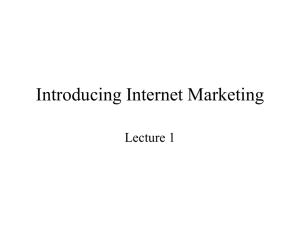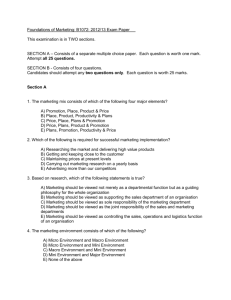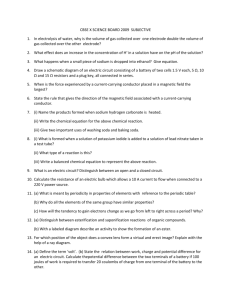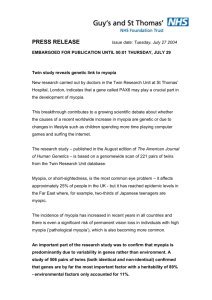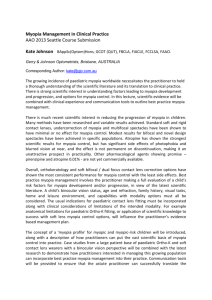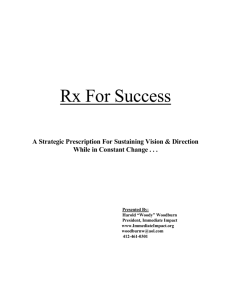refractive errors
advertisement
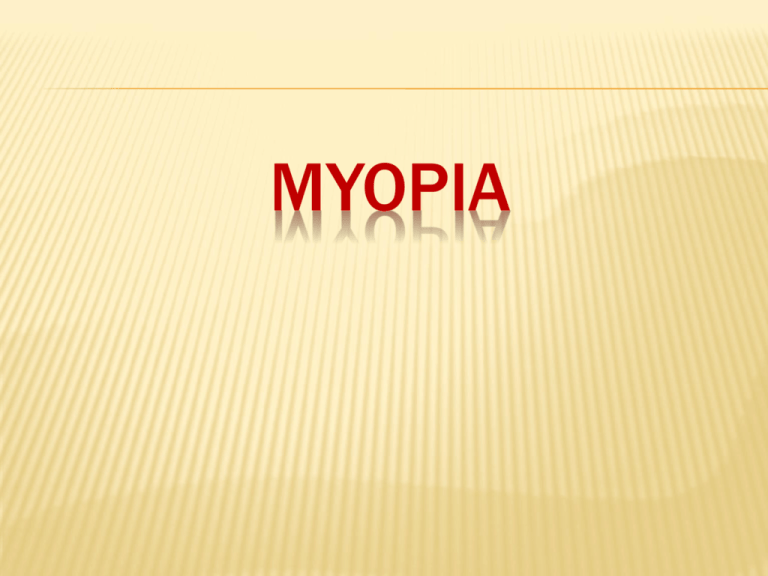
MYOPIA WHAT IS THE SHORT-SIGHTEDNESS (MYOPIA) Nearsightedness (myopia) - a disease in which a person is ill distinguish objects located in the far distance. When myopia is not necessary to image a specific area of the retina, and arranged in a plane in front of it. Therefore, it is perceived by us as fuzzy. This happens due to the mismatch forces the optical system of the eye and length. Usually when myopia increased size of the eyeball (axial myopia), although it can also occur as a result of excessive force refracting apparatus (refractive myopia). The greater the discrepancy, the more short-sightedness. THE CAUSES OF MYOPIA Myopia is very common. According to statistics, more than 1 billion people in the world suffer from myopia.? The reasons for the development of myopia most often are: The irregular shape of the eyeball - when the length of the anteroposterior axis of the eye more than the norm, and the light rays focus, just do not reach the retina. When the elongated shape of the eyeball occurs stretching back of the eye, and a state of the visual system can cause changes in the fundus (degenerative changes in the macular area, retinal detachment, myopic cone, etc.). Too strong refraction of light rays by the optical system of the eye (lens, cornea). The dimensions of the eye are normal, but due to the strong refractive optical unit converges the light rays to focus in front of the retina, rather than in it. PREDISPOSING FACTORS The hereditary factor. According to experts, is not inherited by poor eyesight, and physiological predisposition. As well as, for example, hair color, eyes, face shape, inherited the size of the eyeball or the refractive properties of the lens. At risk is primarily fall into those with both parents suffer from this disease. The presence of myopia only one parent reduces the risk of myopia in a child by an average of 30%. Attenuation scleral tissue increases the size of the eyeball under high intraocular pressure (18-24 mm. Hg. V.) And as a consequence, contributes to the development of myopia. The primary weakness of accommodation, leading to compensatory stretching of the eyeball. Weakening of the body as a result of malnutrition, overwork, a number of diseases. Such as: disorders of the musculoskeletal system: flat feet, scoliosis, and so on. etc .; allergic and infectious diseases: measles, scarlet fever, diphtheria, tuberculosis, infectious hepatitis, etc .; birth injuries; brain trauma; diseases of the nasopharynx and oral cavity: tonsillitis, sinusitis, adenoids; rickets; general decline in immunity. Unfavorable conditions of visual work excessive strain on the eyes, eyestrain; reading in moving vehicles, in darkness, in the supine position; many hours sitting at the computer, TV; inadequate lighting; wrong landing during reading, writing. CONGENITAL MYOPIA According to statistics, 80% of children are born hyperopia (having a good distance vision, near poor). This state of the visual system due to short anteroposterior axis of the orbit of the newborn (16-18 mm). In the future, the growth and the child and the eyeball, hyperopia gradually decreases and some of the children goes into myopia. HOW TO DETERMINE THE SHORT-SIGHTEDNESS OF THE CHILD? As you know, in the early stages of development, many diseases can be treated much better, this also applies to short-sightedness. A child can not complain about you to what he sees bad, because he simply does not know the difference between "seeing bad" and "good to see." Therefore, if you notice that your child gets tired easily when reading, low bending over a book or notebook, periodically complains of headaches, often blinks, rubs his eyes cams - seek medical attention immediately ophthalmologist! Remember that only a specialist can diagnose the disease in time and appropriate treatment! PREVENTION OF IRREGULAR VISUAL HABITS But in addition to all parents should deal with the prevention of irregular visual habits in their children. Teach them to sit at a desk. Take care that during the light fell on the book or notebook evenly, at the same time the head and face are to remain in the shadows. It is best to engage with a desk lamp, leaving the general lighting. This is especially important at night. Should be avoided tilt the child's head close to the subject of work, it is better for distance visual activity - 30-35 cm. It is desirable to exclude from the field of view of the child during various glare or reflecting surfaces. Habit to read lying down may be the one of the more provocative myopia factors. Need to take a break after every 30-35 minutes of work at the desk (for younger students 20-25 minutes), during which you can eat, perform exercises for the eyes, exercise, workout or just relax. PREVENTION OF MYOPIA Life in the modern metropolis is impossible without such creature comforts as a computer, TV. But they are the most adversely affect the condition of view. According to the World Health Organization is currently about 1 billion people in the world wear glasses or contact lenses, ie. E. Have certain eye problems, and that one in six people! Adhering to the simple rules, you can pause the progression of myopia. OBSERVE THE CORRECT MODE OF VISUAL WORK During prolonged and intense visual work at close, a fixed distance is several times reduces the frequency of blinking. Corneal surface "dry", the tear film is updated less frequently. Arising out of the burning, pain in the eyes, dryness, discomfort the first signs appeared "dry eye syndrome". In this continuous voltage of the visual apparatus, called "spasm of accommodation" slows down or even stagnation of the necessary metabolic processes in the structure of the eye and, as a consequence, the development of myopia. PAY ATTENTION TO LIGHTING One of the necessary conditions for the normal visual work - good and, most importantly, properly chosen lighting. It is important to remember that the light on the desktop must be installed so that it is comfortable for your eyes. It should not be too bright, so as not to dazzle you, but not too dark to work in the eyes did not experience excessive surge. It is desirable that the lighting was uniform, except discomfort when glancing from brighter to darker subject. The most expedient combination of local and general light, as when using only local lighting it could not provide the necessary uniformity. ? If you work in an office, you should use mixed lighting - daylight and artificial. It is desirable that the luminous flux is not perceived by the eye as separate. The lack of differences in light would be ideal for eye health. Also, try to exclude from the field of view during various glare or reflecting surfaces. DO NOT READ IN THE TRANSPORT AND LYING During the ride in the truck due to irregularities in the road, and when reading lying under the influence of breath, palpitations, trembling hand book (magazine) and the reader's eyes are in constant motion relative to each other. As a result of the eye by means of accommodation unit has to constantly adjust to the object of observation at all times been in the focus of the maximum distinction that leads to the rapid exhaustion of the visual system, and at length - a spasm of accommodation. Distance to the book, magazine, newspaper should be 30-40 cm. PERIODICALLY MAKE EYE EXERCISES Look at the tip of the nose, on the 1-4, and then move the view of the score 1-6. Repeat 4-5 times. Look at your index finger, removed from the eye at a distance of 25-30 cm, and the 1-4 zoom in to the tip of his nose, then move the eye into the distance on the 1-6. Repeat 4-5 times. Zazhmurte eyes tightly for a few seconds, then open them and look into the distance. Repeat 4-5 times. Keep your head straight. Blink, close your eyes and sit quietly for about 5 seconds. Repeat 4-5 times. Look out the window at a very distant object and inspect it for 10 seconds. Move the view of the palm. Repeat 6-10 times. It is important to remember that at any age need to strengthen the body, move more, eat right, spend free time outdoors.

